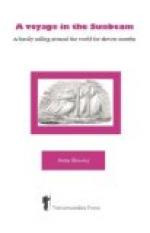[Footnote 16: I have since heard that there are two hotels at Tokio, such as they are.]
Our first halting-place was at the Temple of Shiba, not far from the station, where most of the Tycoons have been buried. It is a large enclosure, many acres in extent, in the centre of the city, with walls overgrown with creepers, and shadowed by evergreen trees, amid whose branches rooks caw, ravens croak, and pigeons coo, as undisturbedly as if in the midst of the deepest woodland solitude. I had no idea there was anything so beautiful in Japanese architecture as this temple. The primary idea in the architecture of Japan is evidently that of a tent among trees. The lines of the high, overhanging, richly decorated roofs, with pointed gable ends, are not straight, but delicately curved, like the suspended cloth of a tent. In the same way, the pillars have neither capital nor base, but seem to run through the building perpendicularly, without beginning or end. The principal temple was burnt down a few years ago; but there are many smaller ones remaining, built in exactly the same style, and all the tombs are perfect. Some people say the bodies are enclosed in coffins, filled with vermilion, but I need hardly say we had no opportunity of ascertaining the correctness of this statement. We entered several of the temples, which are perfect marvels of carving, gilding, painting, and lacquer work. Their style of decoration may be somewhat barbaric; but what a study they would form for an artist! Outside, where no colour is used, the overhanging roofs and the walls are carved with a depth and boldness, and yet a delicacy, I have seldom seen equalled; the doors and railings being of massive bronze, brought from the Corea. Within, a dim religious light illumines and harmonises a dazzling mass of lacquer, gold, and painting. It is the grandest burial-place imaginable; too good for the long line of men who have tyrannised over Japan and its lawful sovereigns for so many centuries past.
The streets of Tokio were crowded with a motley throng up to the very gates of the citadel, where, within the first moat, stand all the yashgis, or residences of the Daimios. Each yashgi is surrounded by a blank wall, loopholed, and with a tower at each of the four corners. Within this outer wall is the court of the retainers, all of them ‘two-sworded’ men; then comes a second wall, also loopholed, inside which dwell distant relations of the Daimio; and then again a third enclosure, guarding the Daimio himself, with his immediate belongings. After crossing the third moat we reached the Mikado’s gardens and palace, the public offices, and the residences of the foreign Ministers, all of which were formerly occupied by the Tycoon, or Shogun, and his ministers. On the waters of the inner moat were thousands of wild ducks and geese. Nobody is allowed to harm them, and the birds seem to be perfectly aware of this fact, for they disport themselves with the greatest confidence.




